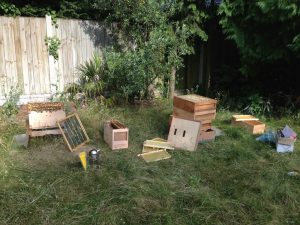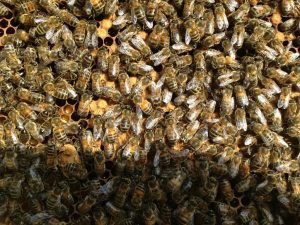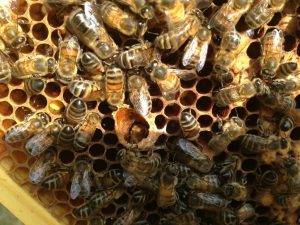
 |
| Things got chaotic when I discovered lots of queen cells in the hive |
After returning from holiday, I inspected the hive and couldn’t believe how many queen cells there were. Something was clearly wrong, so I called me bee mentor who explained this could be a sign that the bees were preparing to swarm.
 |
| Sealed queen cell |
 |
| Open queen cell from hatched queen |
I was advised to split the hive so this is what I did…
Splitting an existing hive with no queen into two hives with queens
- I inspected every frame on the existing hive and located the best looking queen cells.
- I set up a new empty nucleus hive a few metres next to the existing hive.
- From the existing hive, I transferred one brood frame with a good queen cell (you could see the larva inside as it hadn’t been sealed yet) into the nucleus hive. On the frame that I transferred I destroyed all the other queen cells.
- So the nucleus hive now contained one frame with the queen cell. From the existing hive I also transferred a frame of stores and a frame of brood which I placed either side of the queen frame. A dummy board was inserted.
- Then I shook bees from a single frame from the existing hive into the nucleus hive to increase the population of the new colony (before returning the shook frame to the existing hive).
- The nucleus hive was then closed and the front entrance stuffed with some grass.
 |
| Some grass stuffed into the entrance of the new nucleus hive |
- In the existing hive, I destroyed all the queen cells except 2 which were sealed (if I could see the larva at the unsealed stage I would have just kept one).
2-3 days later…
 |
| A branch was deliberately placed in front of the hive to force the bees to take an orientation flight |
- I placed a branch in front of the nucleus hive entrance so that when the entrance grass was removed, the bees saw a new environment which forced them to take an orientation flight (preventing them from returning to the existing hive).
- I inspected both hives and could see that in the existing hive the 2 queen cells had both hatched (so the colony would have to select 1 queen which would subsequently go on a mating flight). In the nucleus hive, the previously unsealed queen cell was now sealed so was developing as expected.
9-10 days later…
- The nucleus hive was opened and the queen had successfully mated as there were new larvae.
- The existing hive was also checked and there were lots of eggs cells and also a sighting of the queen bee confirming successful mating.
- The frames from the nucleus hive were removed and inserted into a new hive at the same site. A contact feeder was placed on the new hive to help build up the colony.
So after all this time, what had seemed like a potentially disastrous situation actually resulted in the production of two colonies from one, both with new queen bees.
To find out more about what to do when you have too many queen cells in the hive see this excellent guide from the Welsh Beekeepers Association: ‘There are queen cells in my hive – what should I do?’.
This is an instructive and informative post. Nice to read the worthy piece of information shared. Keep sharing post like this. Many Thanks.
Thanks, I’m glad you found it useful. Do let me know if there are any topics you would like covered in my blog. You can post your questions here or see the Contact me page above for further details.